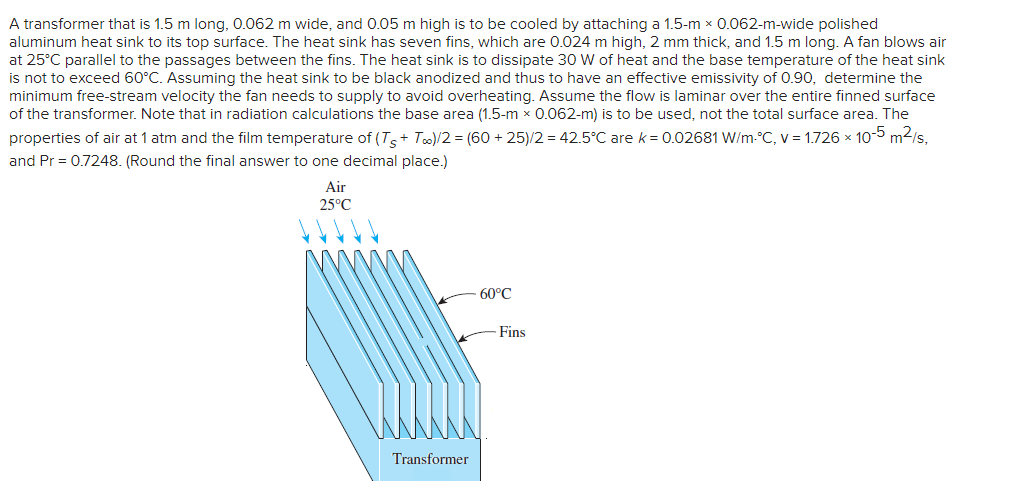A transformer that is 1.5 m long, 0.062 m wide, and 0.05 m high is to be cooled by attaching a 1.5-m x 0.062-m-wide polished aluminum heat sink to its top surface. The heat sink has seven fins, which are 0.024 m high, 2 mm thick, and 1.5 m long. A fan blows air at 25°C parallel to the passages between the fins. The heat sink is to dissipate 30 W of heat and the base temperature of the heat sink is not to exceed 60°C. Assuming the heat sink to be black anodized and thus to have an effective emissivity of 0.90, determine the minimum free-stream velocity the fan needs to supply to avoid overheating. Assume the flow is laminar over the entire finned surface of the transformer. Note that in radiation calculations the base area (1.5-m x 0.062-m) is to be used, not the total surface area. The properties of air at 1 atm and the film temperature of (T+ Too)/2 = (60 + 25)/2 = 42.5°C are k = 0.02681 W/m.°C, v = 1.726 × 10-5 m2/s,
A transformer that is 1.5 m long, 0.062 m wide, and 0.05 m high is to be cooled by attaching a 1.5-m x 0.062-m-wide polished aluminum heat sink to its top surface. The heat sink has seven fins, which are 0.024 m high, 2 mm thick, and 1.5 m long. A fan blows air at 25°C parallel to the passages between the fins. The heat sink is to dissipate 30 W of heat and the base temperature of the heat sink is not to exceed 60°C. Assuming the heat sink to be black anodized and thus to have an effective emissivity of 0.90, determine the minimum free-stream velocity the fan needs to supply to avoid overheating. Assume the flow is laminar over the entire finned surface of the transformer. Note that in radiation calculations the base area (1.5-m x 0.062-m) is to be used, not the total surface area. The properties of air at 1 atm and the film temperature of (T+ Too)/2 = (60 + 25)/2 = 42.5°C are k = 0.02681 W/m.°C, v = 1.726 × 10-5 m2/s,
Principles of Heat Transfer (Activate Learning with these NEW titles from Engineering!)
8th Edition
ISBN:9781305387102
Author:Kreith, Frank; Manglik, Raj M.
Publisher:Kreith, Frank; Manglik, Raj M.
Chapter7: Forced Convection Inside Tubes And Ducts
Section: Chapter Questions
Problem 7.17P: Determine the rate of heat transfer per meter length to a light oil flowing through a 2.5-cm-ID,...
Related questions
Question

Transcribed Image Text:A transformer that is 1.5 m long, 0.062 m wide, and 0.05 m high is to be cooled by attaching a 1.5-m x 0.062-m-wide polished
aluminum heat sink to its top surface. The heat sink has seven fins, which are 0.024 m high, 2 mm thick, and 1.5 m long. A fan blows air
at 25°C parallel to the passages between the fins. The heat sink is to dissipate 30 W of heat and the base temperature of the heat sink
is not to exceed 60°C. Assuming the heat sink to be black anodized and thus to have an effective emissivity of 0.90, determine the
minimum free-stream velocity the fan needs to supply to avoid overheating. Assume the flow is laminar over the entire finned surface
of the transformer. Note that in radiation calculations the base area (1.5-m x 0.062-m) is to be used, not the total surface area. The
properties of air at 1 atm and the film temperature of (T+ T)/2 = (60 + 25)/2 = 42.5°C are k= 0.02681 W/m-°C, v = 1.726 x 1o-5 m2/s,
and Pr = 0.7248. (Round the final answer to one decimal place.)
Air
25°C
60°C
Fins
Transformer
Expert Solution
This question has been solved!
Explore an expertly crafted, step-by-step solution for a thorough understanding of key concepts.
This is a popular solution!
Trending now
This is a popular solution!
Step by step
Solved in 3 steps with 3 images

Knowledge Booster
Learn more about
Need a deep-dive on the concept behind this application? Look no further. Learn more about this topic, mechanical-engineering and related others by exploring similar questions and additional content below.Recommended textbooks for you

Principles of Heat Transfer (Activate Learning wi…
Mechanical Engineering
ISBN:
9781305387102
Author:
Kreith, Frank; Manglik, Raj M.
Publisher:
Cengage Learning

Principles of Heat Transfer (Activate Learning wi…
Mechanical Engineering
ISBN:
9781305387102
Author:
Kreith, Frank; Manglik, Raj M.
Publisher:
Cengage Learning